Genius loci
RAVELLO, CLOSER TO HEAVENS THAN TO THE SEA
Jewel of the Divine Coast
The legend says that Satan, when tempting Christ with the glamour of this world, presented him the dramatically beautiful sights of the Amalfi Coast. This is where Wagner found inspiration for the enchanted gardens of King Klingsor in ”Parsifal”, some of the palaces were described in Boccaccio’s ”Decameron”, and D. H. Lawrence wrote many chapters of ”Lady Chatterley's Lover”. What else should one have in mind for the first trip to this edge of the Tyrrhenian Sea (afterwards you will know yourself)?
By: Dubravka Preradović
Photo: Serpil Ujar
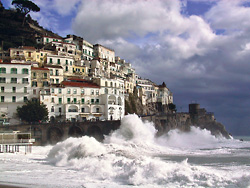 Today, in the era of mass tourism, the frenetic rhythm of everyday life changed the needs of the contemporary human for resting, thus imposing new standards in the considerably broadened tourism offer. Since a pleasant natural surrounding and high quality traffic and accommodation infrastructure are implied, the offer was expanded in line with the potentials of the destination. So, besides usual balnear, mountain or spa tourism, we also have the opportunity to choose cultural, eco, gastronomical or wine tourism… Many will agree that the greatest luxury today are peace and quiet, and there are a few destination which, besides natural surroundings, rich cultural heritage and gastronomical offer, can also fulfill such requests. Today, in the era of mass tourism, the frenetic rhythm of everyday life changed the needs of the contemporary human for resting, thus imposing new standards in the considerably broadened tourism offer. Since a pleasant natural surrounding and high quality traffic and accommodation infrastructure are implied, the offer was expanded in line with the potentials of the destination. So, besides usual balnear, mountain or spa tourism, we also have the opportunity to choose cultural, eco, gastronomical or wine tourism… Many will agree that the greatest luxury today are peace and quiet, and there are a few destination which, besides natural surroundings, rich cultural heritage and gastronomical offer, can also fulfill such requests.
 One such destination is certainly the Amalfi Coast, part of the Tyrrhenian Sea coastline from the western part of the Salerno Bay, from Positano, Amalfi, Atrani, Maiori and Minori to Cetara and Vietri sul Mare (at sea), the coast named divine with a reason. One such destination is certainly the Amalfi Coast, part of the Tyrrhenian Sea coastline from the western part of the Salerno Bay, from Positano, Amalfi, Atrani, Maiori and Minori to Cetara and Vietri sul Mare (at sea), the coast named divine with a reason.
The Amalfi Coast was enlisted in the UNESCO list of world cultural heritage as a unique cultural landscape in 1997, one of the 66 in the world up to now. It is a special category reflecting the long and direct interaction of human and nature in a unique manner. Besides the mentioned coastal settlements, the protected territory also i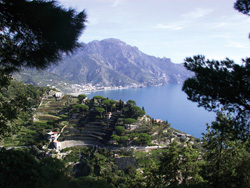 ncludes Scala, Tramonti and Ravello, located in the immediate hinterland, the territory of the formerly powerful naval Republic of Amalfi, which already in the X century developed commercial relations with the Byzantine and Arab world. The influences of these cultures, as well as the Norman that became dominant during the Middle Ages, can still be seen today in the preserved architectural monuments as well as in the tradition of the entire Amalfi Coast. ncludes Scala, Tramonti and Ravello, located in the immediate hinterland, the territory of the formerly powerful naval Republic of Amalfi, which already in the X century developed commercial relations with the Byzantine and Arab world. The influences of these cultures, as well as the Norman that became dominant during the Middle Ages, can still be seen today in the preserved architectural monuments as well as in the tradition of the entire Amalfi Coast.
Although each of the mentioned places deserves equal attention, we decided to dedicate a few more words to Ravello, both due to its dominant geographic position and unforgettable view of the famous Amalfi lemon terraced plantations which go down almost to the shore, and for its rich cultural heritage concentrated in such a small area.
IN ”THE GARDEN OF THE SOUL”
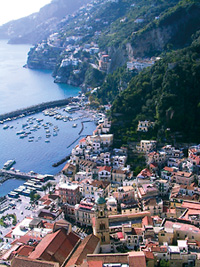 Ravello was formed in the V century on a long and extremely high ridge, which offered a natural sanctuary to the newly arrived inhabitants from the conquests of the barbarian hordes. The rapid demographic growth and establishing of the patrician class of rich merchants made Ravello an important element of the Amalfi Republic already in the IX century. Ravello was formed in the V century on a long and extremely high ridge, which offered a natural sanctuary to the newly arrived inhabitants from the conquests of the barbarian hordes. The rapid demographic growth and establishing of the patrician class of rich merchants made Ravello an important element of the Amalfi Republic already in the IX century.
In the XI century, it became the seat of the episcope, in the Cathedral of St. Panteleimon, the church ornamenting the main city square today. The stairway leads to the central  portal of the three-nave edifice, the monumental relief bronze gate dated 1179. The interior of the church includes characteristic church furnishings, made in marble and ornamented with a mosaic of glass paste and ceramics fragments, while especially remarkable for their refined workmanship are the pulpit and the ambo from the XIII century. If you happen to be in Ravello on the day of the cathedral saint day, on July 27, you will witness an exclusive wonder. On that day, the blood of St. Panteleimon, kept in a glass ampoule in the cathedral treasury, becomes transparent. portal of the three-nave edifice, the monumental relief bronze gate dated 1179. The interior of the church includes characteristic church furnishings, made in marble and ornamented with a mosaic of glass paste and ceramics fragments, while especially remarkable for their refined workmanship are the pulpit and the ambo from the XIII century. If you happen to be in Ravello on the day of the cathedral saint day, on July 27, you will witness an exclusive wonder. On that day, the blood of St. Panteleimon, kept in a glass ampoule in the cathedral treasury, becomes transparent.
 Rich merchant families financed the construction of churches and palaces. The Rufolo family villa, built around 1280 and described in Boccaccio’s Decameron, has been preserved to the very day. At the time of its greatest glory, it had more rooms than days in a year. Still, more glorious than its Mavarian style towers and inside yards is its garden, also called ”the garden of the soul”. The garden today covers only two levels, while in the past it was similar to the hanging gardens of the Arab world, with special water transfer systems. The ”Rufolo” villa garden left Richard Wagner breathless; this is where he found inspiration for the enchanted gardens of King Klingsor in his Parsifal opera. Rich merchant families financed the construction of churches and palaces. The Rufolo family villa, built around 1280 and described in Boccaccio’s Decameron, has been preserved to the very day. At the time of its greatest glory, it had more rooms than days in a year. Still, more glorious than its Mavarian style towers and inside yards is its garden, also called ”the garden of the soul”. The garden today covers only two levels, while in the past it was similar to the hanging gardens of the Arab world, with special water transfer systems. The ”Rufolo” villa garden left Richard Wagner breathless; this is where he found inspiration for the enchanted gardens of King Klingsor in his Parsifal opera.
The memory of Wagner is still alive in Ravello. The prestigious ”Ravello Music Festival”, also known as ”Wagner’s Festival” has been held in the ”Rufolo” villa garden since 1953. Since recently, some concerts are held in the Auditorium, designed by Oscar Niemeyer, famous Brazilian architect, adding Ravello to the map of the most significant achievements of contemporary architecture.
A VIEW FROM ”THE BALCONY OF INFINITY”
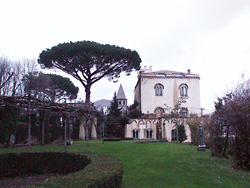 The visit to Ravello cannot be complete without visiting the ”Cimbrone” villa. It was built in the early XX century by an English banker William Becket, later Baron Gripthorp, on the foundations of a XI century edifice, imitating classic and medieval models. He decorated the spacious gardens of the villa with numerous statues and busts. The interesting part is the belvedere, ”the balcony of infinity”, located on the very edge of a high cliff. The visit to Ravello cannot be complete without visiting the ”Cimbrone” villa. It was built in the early XX century by an English banker William Becket, later Baron Gripthorp, on the foundations of a XI century edifice, imitating classic and medieval models. He decorated the spacious gardens of the villa with numerous statues and busts. The interesting part is the belvedere, ”the balcony of infinity”, located on the very edge of a high cliff.
While the villa was in the possession of the Becket family, many famous people spent their vacations here, such as Virginia Wolf, D. H. Lawrence (who wrote many chapters of Lady Chatterley’s Lover here), T. S. Eliot, Winston Churchill, as well as the Duke and Duchess of Kent. In the late 1930s, a frequent guest of the villa ”Cimbrone” was the capricious film diva Greta Garbo. Now the villa is turned into a hotel with an own heliport, guaranteeing its guests complete privacy.
 Ravello is imbued with the fragrance of lemons, which numerous trees are cultivated in a terraced terrain, the main feature of the landscape along the entire coast. The lemon cultivated along the Amalfi Coast, the so-called Sfusato Amalfitano, is marked as IGP (indicazione geografica protetta), guaranteeing its protected origin and controlled quality. The fruit with a mesocarp is light yellow and less sour than common lemon. That is why this lemon is suitable not only for famous deserts such as delicia al limone, but also for different versions of paste al limone such as spaghetti al amalfitana which are the region’s specialty, as well as for marinated anchovies, the common starter on the local menu. Naturally, the pleasure would not be complete without ending the meal with a homemade limoncello. Ravello is imbued with the fragrance of lemons, which numerous trees are cultivated in a terraced terrain, the main feature of the landscape along the entire coast. The lemon cultivated along the Amalfi Coast, the so-called Sfusato Amalfitano, is marked as IGP (indicazione geografica protetta), guaranteeing its protected origin and controlled quality. The fruit with a mesocarp is light yellow and less sour than common lemon. That is why this lemon is suitable not only for famous deserts such as delicia al limone, but also for different versions of paste al limone such as spaghetti al amalfitana which are the region’s specialty, as well as for marinated anchovies, the common starter on the local menu. Naturally, the pleasure would not be complete without ending the meal with a homemade limoncello.
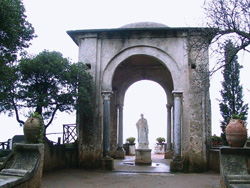 The story of Ravello does not end here. It only begins. Many couples from all over the world decide to begin their life together in this place, so, especially during the tourist season, wedding bells are often heard from the cathedral tower. Furthermore, numerous artists, motivated by the beauty of the natural surroundings, visit this part of the world throughout the year looking for inspiration for writing, painting or composing, because, as the French writer Andre Gide said, ”Ravello is closer to heavens than to the coast”. The story of Ravello does not end here. It only begins. Many couples from all over the world decide to begin their life together in this place, so, especially during the tourist season, wedding bells are often heard from the cathedral tower. Furthermore, numerous artists, motivated by the beauty of the natural surroundings, visit this part of the world throughout the year looking for inspiration for writing, painting or composing, because, as the French writer Andre Gide said, ”Ravello is closer to heavens than to the coast”.
***
Temptation
According to an ancient legend, which can be heard today from the local tourist guides, due to the view of the Mediterranean and the dramatic Amalfi Coast, leaving an observer breathless, Satan took Christ to Ravello during his second temptation, to show him the beauty of the earthly kingdom (Luka 4: 5-8).
***
St. John del Toro
Besides the cathedral, one should also visit the Church of St. John del Toro from the same period. Many consider the pulpit of this church more beautiful than the one in the cathedral. Contributing to this opinion is the fact that its interlocking motifs were an inspiration to the famous Dutch graphic artist M. K. Escher, who spent time in Ravello during the 1920s.
|
